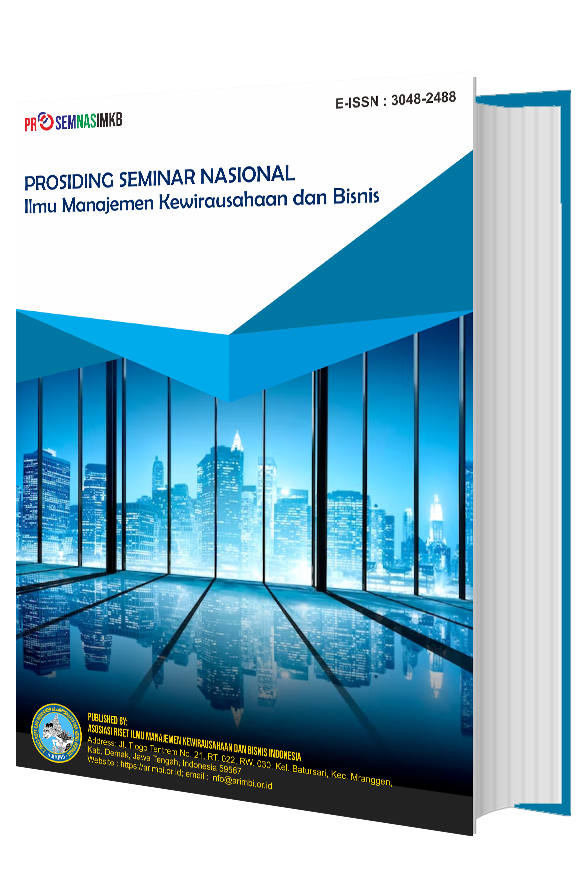Perilaku Konsumen di Era Disrupsi : Peran Interaksi Parasosial terhadap Niat Beli Produk Kolaborasi
DOI:
https://doi.org/10.61132/prosemnasimkb.v2i2.193Keywords:
Brand Credibility, Brand Image, Celebrity Congruence, Parasocial Interaction, Stimulus Organisme ResponseAbstract
This study aims to examine the factors that influence the intention to purchase local brand shoes, using the Stimulus Organism Response (SOR) framework. The main focus of this study is to examine the influence of parasocial interaction, brand credibility, celebrity congruence, and brand image on the purchasing intentions of Generation Z in DIY. The method used is quantitative research involving 184 respondents, using purposive sampling and data collection using questionnaires. Data analysis was performed using Structural Equation Model (SEM) – Partial Least Square (PLS). The results show that parasocial interaction has a positive but insignificant effect on brand image. Conversely, parasocial interaction has a positive and significant effect on purchase intention. Brand image cannot mediate the relationship between parasocial interaction and purchase intention. Brand credibility has a positive and significant effect on brand image but a negative and insignificant effect on purchase intention. Brand image acts as a significant mediator in the relationship between brand credibility and purchase intention. In addition, celebrity congruence also shows a positive and significant effect on brand image and purchase intention, with brand image functioning as a significant mediator in this relationship. This study provides important insights for the marketing strategies of local shoe brands that use influencer promotion.
Downloads
References
Ali, A., Xiaoling, G., Sherwani, M., & Ali, A. (2018). Antecedents of consumers’ Halal brand purchase intention: An integrated approach. Management Decision, 56(4), 715–735. https://doi.org/10.1108/MD-11-2016-0785
Anubha. (2023). Mediating role of attitude in halal cosmetics purchase intention: An ELM perspective. Journal of Islamic Marketing, 14(3), 645–679. https://doi.org/10.1108/jima-04-2021-0112
Awawdeh, E., Alhassan, R., & Alalya, A. (2024). The impact of fostering parasocial relationship between influencing entrepreneurs and social media followers on the brand image and the purchase intentions of start-up companies. In K. Al Marri, F. A. Mir, S. A. David, & M. Al-Emran (Eds.), BUiD Doctoral Research Conference 2023 (Vol. 473, pp. 433–445). Springer Nature Switzerland. https://doi.org/10.1007/978-3-031-56121-4_41
Bakker, I., Van Der Voordt, T., Vink, P., & De Boon, J. (2014). Pleasure, arousal, dominance: Mehrabian and Russell revisited. Current Psychology, 33(3), 405–421. https://doi.org/10.1007/s12144-014-9219-4
Bandura, A. (2001). Social cognitive theory: An agentic perspective. Annual Review of Psychology, 52(1), 1–26. https://doi.org/10.1146/annurev.psych.52.1.1
Chung, S., & Cho, H. (2017). Fostering parasocial relationships with celebrities on social media: Implications for celebrity endorsement. Psychology & Marketing, 34(4), 481–495. https://doi.org/10.1002/mar.21001
Dibble, J. L., Hartmann, T., & Rosaen, S. F. (2016). Parasocial interaction and parasocial relationship: Conceptual clarification and a critical assessment of measures. Human Communication Research, 42(1), 21–44. https://doi.org/10.1111/hcre.12063
Dwivedi, A., Nayeem, T., & Murshed, F. (2018). Brand experience and consumers’ willingness-to-pay (WTP) a price premium: Mediating role of brand credibility and perceived uniqueness. Journal of Retailing and Consumer Services, 44, 100–107. https://doi.org/10.1016/j.jretconser.2018.06.009
Erdem, T., & Swait, J. (2004). Brand credibility, brand consideration, and choice. Journal of Consumer Research, 31(1), 191–198. https://doi.org/10.1086/383434
Gong, W., & Li, X. (2017). Engaging fans on microblog: The synthetic influence of parasocial interaction and source characteristics on celebrity endorsement. Psychology & Marketing, 34(7), 720–732. https://doi.org/10.1002/mar.21018
Hair, J. F., Babin, B. J., Black, W. C., & Anderson, R. E. (2018). Multivariate data analysis (8th ed.). Cengage Learning India. https://www.amazon.com/Multivariate-Analysis-Joseph-Anderson-William/dp/9353501350
In’am, M. A., & Prakosa, A. (2023). Faktor-faktor yang memengaruhi kepercayaan merek sepatu olahraga lokal. ULIL ALBAB: Jurnal Ilmiah Multidisiplin, 2(8), 3310–3315. https://doi.org/10.56799/jim.v2i8.1840
Jamal, A., & Goode, M. M. H. (2001). Consumers and brands: A study of the impact of self‐image congruence on brand preference and satisfaction. Marketing Intelligence & Planning, 19(7), 482–492. https://doi.org/10.1108/02634500110408286
Japutra, A., Ekinci, Y., & Simkin, L. (2019). Self-congruence, brand attachment and compulsive buying. Journal of Business Research, 99, 456–463. https://doi.org/10.1016/j.jbusres.2017.08.024
Jonathan, W. (2023). Pengaruh brand image dan brand trust terhadap keputusan pembelian pada sepatu sneakers merek Adidas dan Nike di Kota Palembang. Konsumen & Konsumsi: Jurnal Manajemen, 2(3), 491–506. https://doi.org/10.32524/kkjm.v2i3.856
Karnawati, T. A., & Santoso, R. (2023). Keputusan pembelian sepatu di FU Second Branded Malang yang dipengaruhi oleh gaya hidup, harga dan kualitas produk. INOBIS: Jurnal Inovasi Bisnis dan Manajemen Indonesia, 6(4), 480–487. https://doi.org/10.31842/jurnalinobis.v6i4.292
Kim, H., & Park, M. (2023). Virtual influencers’ attractiveness effect on purchase intention: A moderated mediation model of the product–endorser fit with the brand. Computers in Human Behavior, 143, 107703. https://doi.org/10.1016/j.chb.2023.107703
Kim, W. G., Lee, S., & Lee, H. Y. (2007). Co-branding and brand loyalty. Journal of Quality Assurance in Hospitality & Tourism, 8(2), 1–23. https://doi.org/10.1300/J162v08n02_01
Kurniawan, S. (2019, July 12). Indonesia jadi produsen alas kaki nomor empat dunia. Marketeers. https://www.marketeers.com/indonesia-jadi-produsen-alas-kaki-nomor-empat-dunia/
Laila, R., & Sjabadhyni, B. (2018). The influence of celebrity endorsement types and congruency celebrity with the body care products on Instagram users’ intention to purchase. In Proceedings of the Universitas Indonesia International Psychology Symposium for Undergraduate Research (UIPSUR 2017) (pp. 175–182). Atlantis Press. https://doi.org/10.2991/uipsur-17.2018.28
Lin, L., & Lu, C. (2010). The influence of corporate image, relationship marketing, and trust on purchase intention: The moderating effects of word‐of‐mouth. Tourism Review, 65(3), 16–34. https://doi.org/10.1108/16605371011083503
Mabkhot, H., Isa, N. M., & Mabkhot, A. (2022). The influence of the credibility of social media influencers (SMIs) on the consumers’ purchase intentions: Evidence from Saudi Arabia. Sustainability, 14(19), 12323. https://doi.org/10.3390/su141912323
Maryanto, S., Royhana, A., Dhamatiyo, R., & Setiowati, R. (2024). Influence of social media influencers on parasocial interaction impacts value perception and purchase intention luxury bags. Ilomata International Journal of Management, 5(1), 191–211. https://doi.org/10.52728/ijjm.v5i1.1038
Min, J. H. J., Chang, H. J. J., Jai, T.-M. C., & Ziegler, M. (2019). The effects of celebrity-brand congruence and publicity on consumer attitudes and buying behavior. Fashion and Textiles, 6(1), 10. https://doi.org/10.1186/s40691-018-0159-8
Ohanian, R. (1990). Construction and validation of a scale to measure celebrity endorsers’ perceived expertise, trustworthiness, and attractiveness. Journal of Advertising, 19(3), 39–52. https://doi.org/10.1080/00913367.1990.10673191
Rai, J. S., & Singh, A. (2020). The impact of team association on attendees’ product knowledge and purchase intentions: A case of Indian Premier League. IIM Kozhikode Society & Management Review, 9(2), 202–212. https://doi.org/10.1177/2277975219871341
Rai, J. S., Yousaf, A., Itani, M. N., & Singh, A. (2021). Sports celebrity personality and purchase intention: The role of endorser-brand congruence, brand credibility and brand image transfer. Sport, Business and Management: An International Journal, 11(3), 340–361. https://doi.org/10.1108/SBM-06-2020-0062
Rubin, R. B., & McHugh, M. P. (1987). Development of parasocial interaction relationships. Journal of Broadcasting & Electronic Media, 31(3), 279–292. https://doi.org/10.1080/08838158709386664
Saini, S., & Bansal, R. (2025). Parasocial relationships and self-disclosure: Strengthening brand image through brand attitude in premium cosmetics. Journal of Promotion Management, 31(2), 337–366. https://doi.org/10.1080/10496491.2025.2466585
Shiau, W.-L., Zhou, M., & Liu, C. (2022). Understanding the formation mechanism of consumers’ behavioral intention on Double 11 shopping carnival: Integrating S-O-R and ELM theories. Frontiers in Psychology, 13, 984272. https://doi.org/10.3389/fpsyg.2022.984272
Sukarno, A., Lestari, R. I., Hadioetomo, H., & Sutanto, H. (2024). Product quality dan price terhadap purchase decision pakaian thrifting dengan brand image sebagai variabel intervening. Jurnal EMA, 9(2), 172–182. https://doi.org/10.51213/ema.v9i2.457
Swait, J., Erdem, T., & Peters, T. (2014). Shocks to brand equity: An information economics perspective on the US auto industry 2006–2011. Customer Needs and Solutions, 1(4), 317–332. https://doi.org/10.1007/s40547-014-0026-8
Tran, K. V., & Uehara, T. (2023). The influence of key opinion leaders on consumers’ purchasing intention regarding green fashion products. Frontiers in Communication, 8, 1296174. https://doi.org/10.3389/fcomm.2023.1296174
Wang, M., Sun, L.-L., & Hou, J.-D. (2021). How emotional interaction affects purchase intention in social commerce: The role of perceived usefulness and product type. Psychology Research and Behavior Management, 14, 467–481. https://doi.org/10.2147/PRBM.S301286
Washburn, J. H., Till, B. D., & Priluck, R. (2000). Co‐branding: Brand equity and trial effects. Journal of Consumer Marketing, 17(7), 591–604. https://doi.org/10.1108/07363760010357796
Windya Giri, R. R., & Alfaruqi, F. F. (2023). The effect of endorser credibility on purchase intention mediated by brand attitude and brand credibility on online travel agent Traveloka. Jurnal Manajemen Indonesia, 23(2), 209–220. https://doi.org/10.25124/jmi.v23i2.4295
Yazid, Y., & Kawiryan, H. (2023). How to improve brand image: The role of customer attitude, brand familiarity, brand awareness, and brand extension. Asian Management and Business Review, 3(2), 199–209. https://doi.org/10.20885/AMBR.vol3.iss2.art7
Yuliastuti, H., Mulyono, S., Krisprimandoyo, D. A., & Jusman, I. A. (2024). Analysis of the influence of brand image, price, and product quality on consumer buying intentions in the Indonesian retail market: Mediation by the level of consumer trust. International Journal of Business, Law, and Education, 5(1), 657–667. https://doi.org/10.56442/ijble.v5i1.453
Downloads
Published
How to Cite
Issue
Section
License
Copyright (c) 2025 Prosiding Seminar Nasional Ilmu Manajemen Kewirausahaan dan Bisnis

This work is licensed under a Creative Commons Attribution-ShareAlike 4.0 International License.






